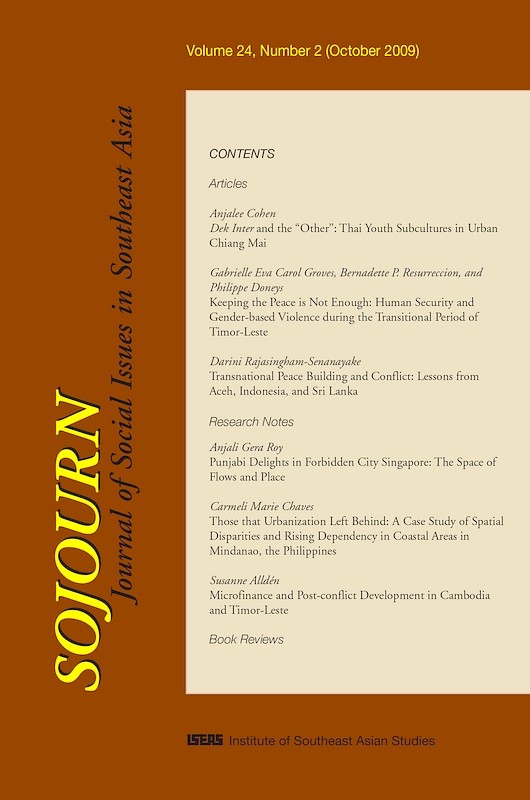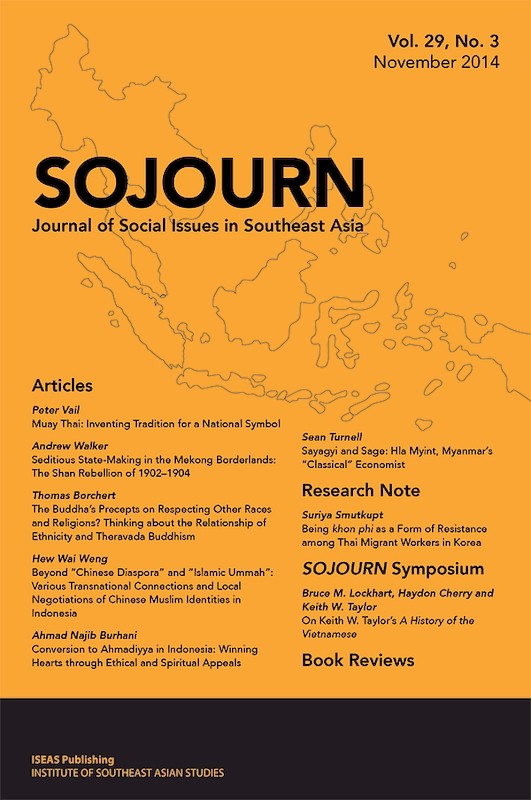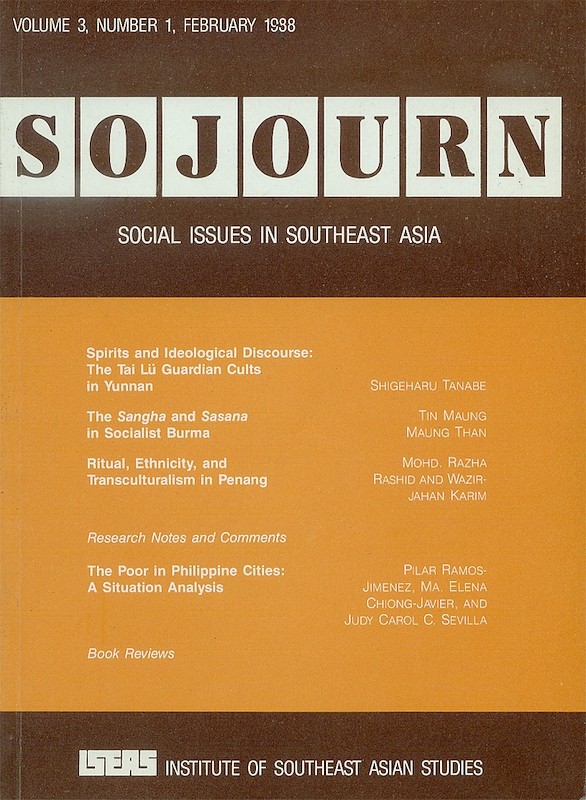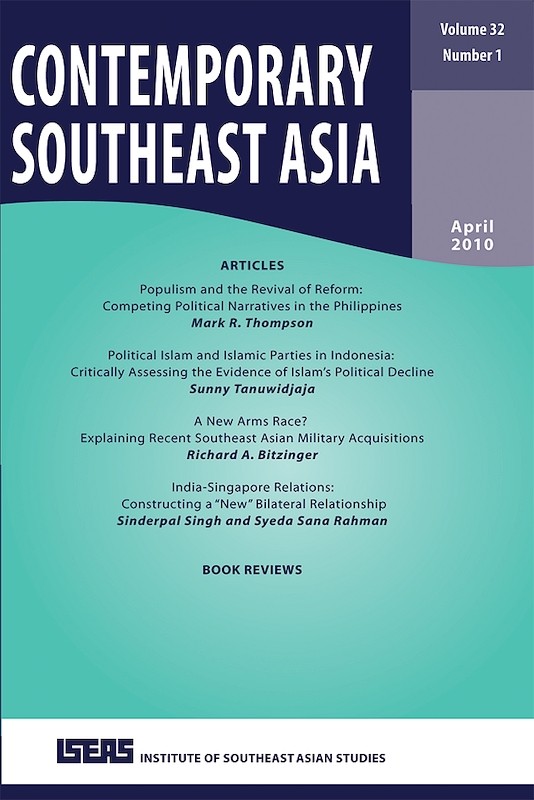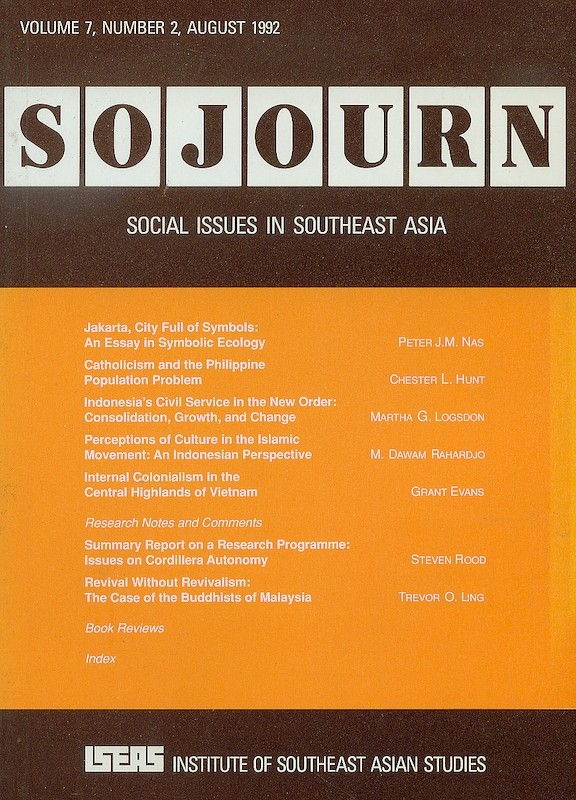SOJOURN: Journal of Social Issues in Southeast Asia Vol. 23/1 (April 2008)

Date of publication:
June 2008
Publisher:
Institute of Southeast Asian Studies
Number of pages:
159
Code:
SJ23/1
Contents
-
SOJOURN: Journal of Social Issues in Southeast Asia Vol. 23/1 (April 2008)
[Whole Publication] -
Preliminary pages
- ARTICLES
-
Sampheng: From Ethnic Isolation to National Integration, by Edward Van Roy, author see abstractBangkok has throughout its 226 year history been a city of multiple ethnic minorities. Over much of that history the most important of those minorities in terms of numbers, economic impact, and cultural influence has been the Chinese. But the Chinese have themselves been divided among a number of distinct ethnic communities. Among them, the Hokkien and Taechiu long engaged in a bitter rivalry, with the latter eventually rising to precedence. That victory was short-lived, however, as the Thai state pursued a vigorous assimilationist policy that succeeded in greatly diffusing Taechiu ethnicity. In reviewing the history of the Taechiu struggle for self-realization within the Thai state and in rivalry with the Hokkien, the Taechiu settlement at Sampheng stands as a tangible symbol of ethnic persistence and adaptation. The story of Sampheng's rise from adversity to economic pre-eminence, followed by its marginalization in the shadow of Taechiu cultural integration into the Thai nation-state, offers an exceptional counterpoint to the many tales of ethnic violence and tragedy that punctuate the pages of Southeast Asian history.
-
"Pirated" Transnational Broadcasting: The Consumption of Thai Soap Operas among Shan Communities in Burma, by Amporn Jirattikorn, author see abstractThis article examines the roles of transnational media in the lives of Shan communities in Burma with a focus on their consumption of Thai satellite television, the main window to the outside world available to them. It will analyse how the Shan appropriation of transnational television creates a new site of identity transcending national boundaries and expressing an ambivalent sense of interaction with mediated modernity. The paper will demonstrate the role of transnational television as a catalyst for the emergence of Shan migration to Thailand.
-
Hare Krishnas in Singapore: Agency, State, and Hinduism, by Rodney Sebastian, Ashvin Parameswaran, authors see abstractThe members of the Hare Krishna movement in Singapore have been subjected to state and social disapproval since the late seventies. In order to gain legitimate space and approval they have adopted various strategies of negotiating their identity within the social structure of Singapore. In this paper, we investigate the transformation of the relationship between State and Hare Krishna and popular Hinduism and Hare Krishna over the past four decades. This paper also serves as a documentation of the growth of the Hare Krishna movement in Singapore. It will be shown that Hare Krishna devotees, while cautious not to provoke the state into sanctioning them, have persisted in their devotional practices and gradually expanded in terms of numbers and social spaces. The social oppression they face has also caused them to re-negotiate their ambiguous identification with popular Hinduism. Interviews with them suggest that the negotiation of identity with Hinduism is complex. Although all of them have a similar understanding of the Hare Krishna philosophy, they employ different definitions of Hinduism and act accordingly.
- RESEARCH NOTES AND COMMENTS
-
Islamic Microfinance in Indonesia: The Challenge of Institutional Diversity, Regulation, and Supervision, by Hans Dieter Seibel, author see abstractForays into Islamic microfinance have been few and scattered and of limited outreach. Some have been mandated by the state, but lack popular demand, as in Iran; others have emerged in response to popular demand, but lack regulatory support by the state, as in Syria. This has provided the background for a more systematic study of Islamic microfinance in Indonesia, the largest Muslim country, where several strands of Islamic microfinance, formal and semi-formal, have evolved since 1990 in parallel. Islamic banking is now officially recognized as part of a dual banking system in Indonesia. Lacking broad popular demand, experience differs by sub-sector. Only commercial banks have successfully acquired the art of Islamic banking by training young and dynamic people, yet lack experience in microfinance. Islamic rural banks, mostly under absentee ownership, have failed to prove themselves as efficient and dynamic providers of microfinance services. Unsupervised Islamic, like conventional, cooperatives are an outright menace to their members, who risk loosing their savings. There are two options of promoting Islamic microfinance: (1) assisting Islamic commercial banks to establish units with Islamic microfinance products; (2) reassessing in a participatory process the challenges and realistic opportunities of Islamic rural banks and cooperatives, with a focus on effective internal control, external supervision, and the establishment of associations with apex services to their member institutions.
- REVIEW ARTICLE
-
Tourism in Asia: A Review of the Achievements and Challenges, by Victor T King, author see abstractReview article on Asian Tourism: Growth and Change, edited by Janet Cochrane (Oxford and Amsterdam: Elsevier Ltd, 2008).
- BOOK REVIEWS
-
Book Review: Myanmar (Burma) since 1962: The Failure of Development, by Peter John Perry., by Ardeth Thawnghmung, author
-
Book Review: Securing a Place: Small-Scale Artisans in Modern Indonesia, by Elizabeth Morrell., by Michael Howard, author
-
Book Review: In the Name of Civil Society: From Free Election Movements to People Power in the Philippines, by Eva-Lotta Hedman., by Ramon Guillermo, author

